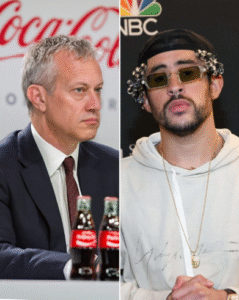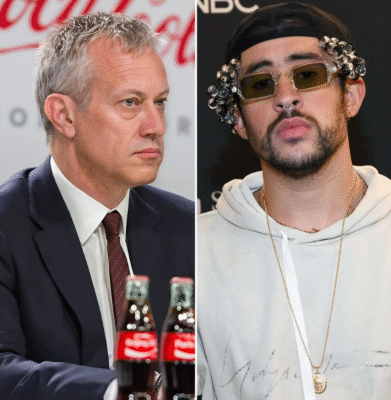
Coca-Cola vs. The NFL: Inside the Corporate Ultimatum That Could Redefine the Super Bowl Halftime Show
For decades, the Super Bowl has been more than just a football game—it has been a cultural moment, a spectacle of entertainment, advertising, and corporate power. Every year, the halftime show becomes one of the most watched performances on Earth, a showcase for the biggest names in music and a reflection of shifting social trends. But behind the glamour lies a growing tension between creativity, sponsorship, and brand control. Recently, that tension reportedly reached a boiling point when whispers began circulating about a dispute between Coca-Cola and the National Football League. Though much of the rumor remains unconfirmed, the discussion it sparked raises deep questions about the future of corporate influence on one of the world’s most-watched events.
The story goes that Coca-Cola, a longtime NFL partner and advertising powerhouse, took issue with the league’s rumored choice of a controversial performer for the next Super Bowl halftime show. Some insiders claim the beverage giant delivered an ultimatum: either change the performer, or risk losing Coca-Cola’s sponsorship dollars. Whether this account is fact or fiction, the idea of such a confrontation isn’t far-fetched. For major corporations like Coca-Cola, image is everything. Every public association is carefully weighed against potential backlash or benefit. And in today’s hyperconnected world, one wrong cultural signal can trigger a firestorm of online outrage.
Historically, the halftime show has served as the crown jewel of the NFL’s partnership with advertisers. When Pepsi sponsored the show, the collaboration gave rise to legendary performances by Beyoncé, The Weeknd, and Lady Gaga—events that doubled as global marketing campaigns. But when Pepsi stepped down as the official halftime sponsor, Apple Music stepped in, bringing a new level of creative freedom and digital integration. Coca-Cola, while not the direct sponsor of the halftime show, has long used Super Bowl advertising to maintain its image as an American classic. Any controversy surrounding the event could easily reflect on Coke, especially given how closely the brand ties itself to themes of unity, joy, and nostalgia.
The supposed ultimatum, then, plays into a larger conversation about who truly controls cultural moments: the artists or the advertisers. If Coca-Cola were to issue a demand that affects the performer lineup, it would mark a historic shift in the balance of power. Traditionally, the NFL has been careful to select artists who are both relevant and broadly appealing, avoiding those who might alienate segments of its diverse audience. Yet as entertainment evolves and artists push creative boundaries, maintaining that balance becomes increasingly difficult. Corporate sponsors, concerned about aligning with messages that might offend certain demographics, may feel compelled to step in.
At the heart of this debate is the evolving nature of the Super Bowl itself. Once viewed purely as a sporting event, it has transformed into a multimedia extravaganza where football, fashion, and pop culture collide. The halftime show can make or break the public perception of the entire event. When Rihanna took the stage in 2023, her performance drew praise for its bold simplicity, but it also sparked debate about its tone and messaging. Every detail—outfits, gestures, even lighting—can ignite online controversy within minutes. For companies spending tens of millions of dollars to advertise during the broadcast, that kind of unpredictability is both a blessing and a curse.
Coca-Cola’s brand has always stood for harmony and tradition, qualities that sometimes clash with the provocative energy of modern pop performances. In that context, the idea that the company might push back against a halftime artist is not impossible. Executives must constantly weigh brand safety against relevance. A bold artist might capture the attention of younger audiences but could alienate more conservative consumers who form the backbone of Coca-Cola’s loyal customer base. The NFL, in turn, must navigate these competing interests while preserving the integrity of its most visible stage.
If such an ultimatum were real, the implications would be enormous. For one, it would reveal just how much power sponsors hold over entertainment decisions. Artists could find themselves screened not only by producers but by corporate boards assessing whether their image aligns with brand values. The halftime show could become more cautious, polished, and predictable—safe from controversy but stripped of spontaneity. Fans might notice the difference. The magic of past shows often came from their risks: Prince performing in the rain, Lady Gaga diving from a stadium roof, or Shakira and Jennifer Lopez making history with a Latin-inspired spectacle. Those moments defined the Super Bowl’s reputation for unforgettable creativity.
On the other hand, the NFL cannot afford to ignore sponsors. The league’s partnerships generate billions in revenue each year, funding everything from marketing campaigns to stadium deals. If Coca-Cola—or any sponsor of its size—were to pull out, it would send shockwaves through the sports and advertising industries. The Super Bowl is not just about entertainment; it’s an ecosystem of business interests. Companies buy influence not only to reach audiences but to shape the tone of the conversation around the event.
Yet the public’s reaction to such a corporate intervention could be unpredictable. Many fans value authenticity and creative freedom. If the halftime show were seen as censored or sanitized by corporate interests, it might lose its cultural resonance. The modern audience, especially younger viewers, tends to reward brands that embrace boldness and social awareness rather than conformity. A move perceived as suppressing artistic expression could damage Coca-Cola’s image far more than any controversial performance ever could. In the age of social media, every decision becomes a public referendum on values.
From a broader perspective, this rumored standoff symbolizes the changing dynamics of modern media. Entertainment, commerce, and politics are increasingly intertwined. Every performance is a marketing opportunity, every sponsorship a statement of alignment. The Super Bowl, once a straightforward celebration of sport, has become a mirror of contemporary society’s debates over identity, inclusion, and influence. Whether the alleged conflict between Coca-Cola and the NFL is real or exaggerated, it touches on a truth that defines our era: the struggle between creativity and control.
As we move closer to future Super Bowls, one thing is certain—the halftime show will continue to be a battleground of artistic vision and corporate caution. The next performer, whoever they may be, will not only entertain millions but also carry the weight of brand expectations, public opinion, and social commentary. Coca-Cola’s rumored stance, whether genuine or not, serves as a reminder of how fragile that balance has become. Behind every dazzling performance lies a negotiation of values, a careful dance between art and advertising.
In the end, the Super Bowl halftime show is a stage unlike any other, where the world watches and judges in real time. If corporate influence grows too strong, the event risks losing the spontaneity and spirit that made it iconic. But if artists and producers can continue to push boundaries while respecting the diversity of their audience, the show will remain the spectacular fusion of sport and art that defines it. Whether Coca-Cola’s ultimatum is myth or message, it raises an essential question: who truly owns the moment—the creators who perform, or the corporations that pay to make it possible? The answer, like the halftime show itself, may depend on what America decides it wants to see when the lights come on

